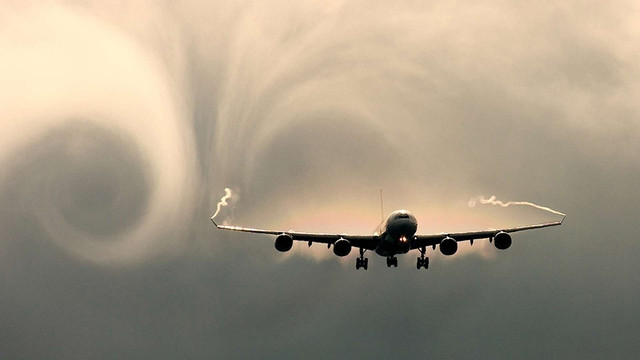Turbulence-related aviation accidents are the most common. One-third of all accidents recorded by the US National Transportation Safety Board involve turbulence.

At around 3:45 p.m. on May 21, a Singapore Airlines plane had to make an emergency landing at Suvarnabhumi Airport (Bangkok, Thailand) after extremely strong air turbulence caused one passenger to die and at least 30 others to be injured.
It is known that this is a flight departing from London (UK) at 22:38 (local time) to Singapore, using a Boeing 777-300ER aircraft. There are a total of 211 passengers and 18 crew members.
According to the Aviation Meteorology Center - Vietnam Air Traffic Management Corporation, atmospheric turbulence is the phenomenon of air currents of different sizes moving erratically over a certain space. For flight operations, atmospheric turbulence is a dangerous weather phenomenon that affects flight operations. Due to the uneven impact of atmospheric turbulence on the fuselage parts, it creates vibrations in the aircraft.
Turbulence is a weather phenomenon that is more dangerous to flight than other types of weather. Small aircraft are affected by strong turbulence even when the turbulence is mild.
Turbulence is the most common aviation accident, according to a 2021 study by the US National Transportation Safety Board. One-third of the accidents the agency recorded involved turbulence, many of which caused serious injuries but did not damage the aircraft.
There are many types of air turbulence, including mechanical turbulence - which occurs when air encounters ground-based obstructions such as mountains or buildings, thermal turbulence - caused by temperature differences, flight path turbulence - caused by air being disturbed after an aircraft passes through it, and turbulence caused by cold and hot air colliding…
According to an expert at the Vietnam Aerospace Association, many modern aircraft are equipped with weather radar and advanced forecasting technologies that help detect air turbulence. However, some types of turbulence, such as clean air turbulence (CAT), cannot be easily detected by radar because they are not related to clouds.
Therefore, pilots are well trained in how to handle turbulence, including staying calm, adjusting flight speed and altitude appropriately to ensure safety, helping to quickly and effectively get the aircraft out of the turbulence area.
Researchers at the University of Reading in the UK estimate that human-caused climate change could more than triple the severity of turbulence between 2050 and 2080. The researchers believe that warming air caused by CO2 emissions is a factor that blocks air circulation, increasing clear-sky turbulence in the North Atlantic and globally.
According to an expert at the Vietnam Aerospace Association, there is no specific rule or data to prove that one aircraft model is better than another in handling turbulence. Size is just one factor, along with many other factors such as aerodynamic design, control systems, aircraft weight, etc. In general, aircraft with large planes are often better at absorbing turbulence. For example, the Airbus A380 and Boeing 747 are considered two of the best turbulence-handling aircraft due to their enormous size.
However, this does not mean that larger aircraft are always better at handling turbulence. For example, some early models of the Boeing 757 – once among the largest aircraft used for short-haul flights – have a history of being vulnerable to turbulence.
According to experts, when a plane encounters turbulence, the most important thing is for passengers to stay calm and follow the flight attendants' instructions. Panicking, screaming or moving suddenly can make the situation more chaotic and potentially cause an accident.
For passengers when traveling by plane, remember to fasten your seat belt throughout the flight, especially when turbulence is forecast. This small action can help reduce the risk of injury from being thrown or bumped in the cabin during turbulence.
In Vietnam, the Aviation Meteorological Center has invested in many modern meteorological equipment, researching and exploiting many sources of reliable and quality meteorological data such as high-resolution satellite cloud images, weather radar, global weather forecast products, digital forecast products, etc. Forecasters are well-trained, have a lot of experience, and regularly exchange and cooperate internationally.
Forecasts, warnings, and meteorological information are updated and provided to air traffic control agencies, flight crews, aircraft operators, and other entities, ensuring completeness, accuracy, timeliness, and high quality throughout the entire flight process, from planning, takeoff, leveling, and landing.
Atmospheric turbulence is one of the dangerous weather phenomena that forecasters of the Noi Bai, Da Nang, Tan Son Nhat Aviation Meteorological Center and the Weather Warning Center of the Aviation Meteorological Center monitor continuously 24/7, issue and advise quickly and accurately.
There have been several incidents in recent months involving severe turbulence. In early March 2023, seven people were hospitalized after severe turbulence occurred on a Lufthansa flight from Austin, Texas, to Frankfurt, Germany, NBC reported. The flight, carrying 184 people, was forced to divert and eventually landed safely.
In December 2022, a Hawaiian Airlines flight from Phoenix, Arizona to Honolulu, Hawaii (USA) encountered severe turbulence that injured 25 people. According to Hawaiian Airlines, the flight was carrying 278 passengers. The turbulence was so severe that it damaged the interior of the plane.
In 2021, an American Airlines flight en route to Florida was diverted to Louisiana after turbulence injured 10 people on board.
In 2019, at least 35 people were injured after an Air Canada flight from Toronto, Canada to Sydney, Australia encountered sudden turbulence and was forced to land in Honolulu.